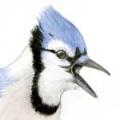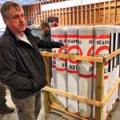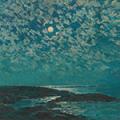Awanadjo Almanack - Issue 110
and previously unimagined beauty
By Rob McCall
 Illustration by Sam Manning.
Illustration by Sam Manning.
Hardships can bring out new and previously unimagined beauty. I think these difficult times have helped me understand better than before how infinitely rich and beautiful life is in every way and that so many things that one goes around worrying about are of no importance whatsoever.
Dear Friends: Last year’s winter was a long one, with more than ample amounts of both cold and snow. Then came a spring during which we saw an unusually heavy bloom on apples and rich, yellow pollen from the white pines lying thickly on every surface. Later we saw a rich bloom on the lupine, and the blue-eyed grass was beginning to open in the fields, showing more than the usual number of tiny pale-blue blossoms on each plant: so also were the ox-eye daisies. Our garden perennials, including iris, peonies, rugosa roses, and echinacea, were lush and thick and loaded with buds. All this pointed to a glorious season of floral profusion ahead. Sure, it’s easy to forget over a long, hard winter just how lush spring can actually be. And, yes, our memory does tend to fade over the years. But, if you are skeptical about this flowery explosion, here are some hard facts: A favorite apple tree at the church which has never had more than a handful of blossoms in any of the past ten years was bedecked in hundreds of fragrant flowers. Our giant California poppy that averages maybe five flowers most years had almost 20 buds. The giant and (frankly) garish purple iris that averages maybe half a dozen flowers most years had close to 50 buds. It went on and on. What happened here? Perhaps it was because we had an extra warm, wet summer the previous year. Perhaps this abundance was because the heavy snows of the previous two winters kept the ground from freezing and minimized winter damage. Or perhaps it was something more. Wild speculation Perhaps there is a law of Nature at work here: that hardships can bring out new and previously unimagined beauty. A forest fire can destroy a forest only to have it come back again richer and greener than before. The sufferings in the lives of a Jesus or Gandhi or Helen Keller or so many others produced incredibly beautiful souls. The periods sometimes called “Dark Ages” in Europe—times of very little art, literature, and philosophy around 1200 to 800 BC and again around 500 to 1200 AD—led in turn to an unprecedented flowering of culture and religion. The Black Plague, which horribly decimated the population of Europe, is widely seen today as the precursor of the glories of the Renaissance. The struggles of two world wars and the Great Depression brought our country from being just another nation among many to being the most culturally innovative and powerful nation the world has yet seen. The questions for us today are: Will the winter of our nation’s present hardships lead in the fullness of time to a new season of the flowering of our ideals and democratic values? That will be up to us. Will our own hardships produce new beauty? In the presence of patience and hope they can, absolutely; if we will keep faith with the flowers.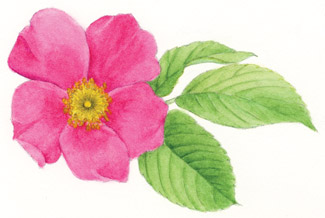 Illustrations by Candice Hutchinson [2].
Illustrations by Candice Hutchinson [2].
Seedpods to carry around with you
From Anne Dudley Bradstreet: “If we had no winter, the spring would not be so pleasant; if we did not sometimes taste adversity, prosperity would not be so welcome.”
And from the late John Updike: “We do survive every moment, after all, except the last one.”
Natural and un-natural events
Some conservative critics of members of the environmental movement vehemently charge them with trying to start a new religion. Many Greens equally vigorously deny the charge. But why fight it? New spiritual visions are an ancient and honorable human tradition.
The Jewish prophets formed a new monotheistic religion built on the old tribal polytheisms of their region. The Muslims did the same. So did the Buddhists, building theirs on the foundation of Hinduism. The new Green Religion has its prophets, such as Emerson and Thoreau, Rachel Carson and Aldo Leopold. It has its saints, such as John Muir and Butterfly Hill. It has its icons, such as the whale, the dolphin, and the wolf. It has its pope, Al Gore. It has its fundamentalists, such as Greenpeace, EarthFirst!, and PETA. It has its vision of the Apocalypse, with the world ending in fire. And, let’s face it, the environmental movement has its heretics and apostates, such as George W. Bush, Donald Trump, and (I fear) myself. It’s time for a penitent confession.
To feel Green, I mow part of our big lawn in Blue Hill with an old-fashioned reel push mower and let much of the grass grow long. I smugly walk all over town. Then, I drive my pickup truck 2 ½ hours to our camp to commune with Nature by mowing down an acre or more with a smoky, gas-guzzling old power mower, while toads, moles, and grasshoppers flee in all directions or are flayed to mush by the roaring monster. I carefully carry spiders and even hornets out of the house, then set mouse traps and ant bait when the little critters get too numerous. I eat organic free-range chicken and brown rice, then turn around and have cheese puffs and a soda for a snack.
Mea culpa, mea maxima culpa! I am drowning polar bear cubs and flooding Bangladesh! I am plagued by Green guilt by day and by night. And I’m not the only one. Good Greens drive their quiet, cute hybrids around town with little thought of how they will dispose of those massive batteries loaded with poisonous heavy metals when the time comes. Polluting industries purchase carbon shares like medieval sinners buying indulgences. Even Pope Gore’s Nashville palace burns more kilowatt hours in a day than an entire Afghan village burns in a year. Alas, we’ve got a long way to go yet.
Rank opinion
Setting aside Green guilt and environmental error for a moment, we have also come a long way. We are right now living through what may be the greatest popular revelation our species has ever experienced.
A mere 50 years ago, educated, knowledgeable people had no sense of the intricately interconnected web of life, no awareness of being part of a whole, living biosphere. But today, Earth flags are flying from Beijing to Baltimore, and wolf T-shirts are worn by children from Texas to Tibet, and we can see them all in our own living rooms. Call it God or Mother Earth, call it the Creator or the Great Spirit, a mighty change is coming, and it is coming fast. It is an exceedingly exciting time to be alive. We are not there yet, and some of us will not see it, but we’re on the way to living once again in an enchanted and enchanting world, and at long last feeling at home in Nature.
More seedpods to carry around with you
From Lyndon Johnson: “If future generations are to remember us with gratitude rather than contempt, we must leave them more that the miracles of technology. We must leave them a glimpse of the world as it was in the beginning, not just after we got done with it.”
And from Wendell Berry: “The only possible guarantee of the future is responsible behavior in the present.”
Field and forest report
Heliotrope, as it is called around here, is in bloom, with its six-foot-tall fluted stems tinted red at the nodes, pinnate leaves, and clusters of aromatic white flowers with a tinge of purple. It’s another of the sweet, sweet presentations of summer. Botanists agree that this plant is not a heliotrope at all, but rather valerian (Valeriana officianalis), from which the highly effective herbal concoction valerian root is drawn. Its pharmaceutical approximation is Valium, a widely used muscle-relaxant and anti-depressant.
With no knowledge of either the herbal or the pharmaceutical applications of this stately plant, it seems to your commentator that the sinfully rich aroma alone confers an intoxicating sense of joy and well-being, to the point that we begin to feel guilty walking near a stand of the plant. I find myself stooping down surreptitiously and inhaling forcefully, then looking around to see if anyone has noticed. Soon I am losing my train of thought, staring at the bright sky, and feeling the day’s plans slipping away while I am hypnotized by the voluptuous odor, the healing balm of summer.
Perhaps to compensate for this pleasure, Mother Nature is presenting us with hordes of earwigs, Forficula auricularia. These flat, red-brown, nocturnal creatures—some nearly an inch long, with an elongated abdomen appended with a pair of fierce, crescent-shaped pincers—look a little like a large ant designed by Salvador Dali or Stephen King. When we move anything that has been sitting outdoors, the earwigs come pouring out in droves. I swore for many years that earwigs did not bite or sting. That conviction ended abruptly not long ago when one got under my clothing and gave me a couple of good pinches in hidden places.
So, yes, they infest our houses and yards. Yes, they move fast. Yes, they run like cockroaches. Yes, they pinch, they swarm in hoards, they leave dusty droppings and a foul odor. But they have also their holy purpose for being here, and their essential job to do (even if we haven’t the faintest idea what it is). Further, they are only with us for a brief two months. And, most winsome of all, we have it on good report that—unlike other non-social insects, and even some humans for that matter—earwigs care for their young. That’s right. The female guards the eggs and watches over them until they are hatched and are big and nasty enough to fend for themselves. You have to admire them for that.
I may heartlessly vacuum up an earwig, or flush one down the toilet instead of catching it and putting it outdoors, as we do with more honored insects. But, I can’t bring myself to squash an earwig, no matter where it appears. Call me sentimental, if you like, or squeamish.
Or write to tell us what you would do with it: awanadjoalmanack@gmail.com.
Saltwater report
Eider ducklings are scurrying about under the watchful eye of their mothers. The male eiders now become absentee fathers by moving out to deeper water, while the mothers and young stay closer to shore, feeding on mussels and diving to avoid the swooping attacks of hungry eagles and ospreys. Young harbor seals are growing quickly and turning from their infant blond and spotted coloration to a darker brown. On the gravel shore at our camp on Cobscook Bay, I found the forlorn cranium of an unfortunate infant seal with the soft folds of its brain molded on the inside of the skull where the wisdom of the great waters once was cradled.
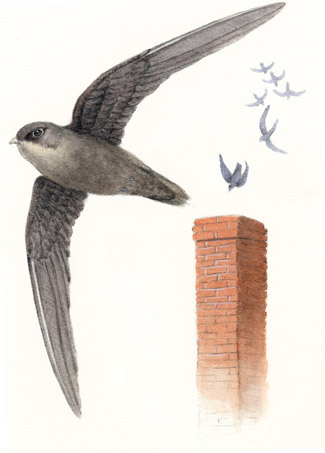 More Natural Events
Around late July we begin to notice the short, crescent shapes of chimney swifts twittering and darting around in great loops that slice the evening sky like little scimitars. Sooner or later if you watch long enough—and if there is another house near enough by—you will see a swift fly through a high arc and then straight down into the dark maw of a neighbor’s chimney at full speed. It is a marvel that they aren’t dashed to bits on the hearth. But somehow they halt their plunge and catch up on the inside of the chimney and there build their nests during the season of the year when it is least likely that the chimney will be smoky and hot. Other birds nest and may raise their young in the spring, but not the chimney swifts.
One day when I was younger and even more foolish, with no instruction whatsoever and the youthful conviction that if I didn’t know everything already I soon would, I determined to start myself out in the chimney-sweeping business. I had heard that the old-timers would tie a rope around the legs of a goose and force it flapping and honking down the chimney. Being too tender-hearted to treat a goose this way, I gathered some steel strapping and tubing from the dump, bought some threaded rod at the hardware store, and soon constructed crude chimney brushes in three sizes.
Thinking that mid-summer would be a good time to start cleaning chimneys for the same reason that the swifts choose mid-summer to live in them—though I did not yet know why—I climbed onto the roof of the colonial farmhouse in West Concord, Massachusetts, of which we were caretakers, and lowered one of my steel brushes down the chimney. As it descended, I could hear an avalanche of matter showering down into the huge fireplace below while a cloud of dust and soot rose from the chimney, filling my nose, blackening my face, and floating into the blue summer sky. After several passes with the brush, I came proudly down off the roof and strode into the house to clean the debris out of the ancient fireplace.
On the hearth I found a pile of brick-red dust, gray ash, and shiny black creosote. Under this heap I saw a faint movement. Reaching into the mess I uncovered a small chimney swift nest. It was like a half moon, flat on one side where it had been affixed to the inside of the chimney. It was carefully fashioned of tiny twigs glued together with a sort of shiny wax, and in its half-pocket were two naked, blind, squirming hatchlings about the size of the last joint of my finger.
My heart broke at what I had done. Trying to be harmless, I had done great harm. Trying to be kind, I had been cruel. I knew that these tiny helpless swifts were doomed and that the twittering cries of their bereft parents, who had wisely obeyed the ways of the ages, were soon to be echoing down the empty chimney. Not wanting to delay the hatchlings’ end, I drowned them in a bucket of water. I never again swept a chimney in mid-summer. Thirty-some years later, I still shudder at how an ignorant and innocent man’s plans can crush the primal generative wisdom of a tiny creature. I know even less now than I did then. I only hope I am a little less foolish, too.
A final seedpod to carry around with you
From Henry Williamson, English novelist and naturalist: “The swift is the mystic among birds. He is aloof from other birds—apart from life. He is never seen to perch… I have heard and seen them long after midnight, whole cohorts of them wheeling in the sky, their cries sounding like the thin jingle of a frail chain.”
That’s the almanack for this time. But don’t take it from us—we’re no experts. Go out and see for yourself.
More Natural Events
Around late July we begin to notice the short, crescent shapes of chimney swifts twittering and darting around in great loops that slice the evening sky like little scimitars. Sooner or later if you watch long enough—and if there is another house near enough by—you will see a swift fly through a high arc and then straight down into the dark maw of a neighbor’s chimney at full speed. It is a marvel that they aren’t dashed to bits on the hearth. But somehow they halt their plunge and catch up on the inside of the chimney and there build their nests during the season of the year when it is least likely that the chimney will be smoky and hot. Other birds nest and may raise their young in the spring, but not the chimney swifts.
One day when I was younger and even more foolish, with no instruction whatsoever and the youthful conviction that if I didn’t know everything already I soon would, I determined to start myself out in the chimney-sweeping business. I had heard that the old-timers would tie a rope around the legs of a goose and force it flapping and honking down the chimney. Being too tender-hearted to treat a goose this way, I gathered some steel strapping and tubing from the dump, bought some threaded rod at the hardware store, and soon constructed crude chimney brushes in three sizes.
Thinking that mid-summer would be a good time to start cleaning chimneys for the same reason that the swifts choose mid-summer to live in them—though I did not yet know why—I climbed onto the roof of the colonial farmhouse in West Concord, Massachusetts, of which we were caretakers, and lowered one of my steel brushes down the chimney. As it descended, I could hear an avalanche of matter showering down into the huge fireplace below while a cloud of dust and soot rose from the chimney, filling my nose, blackening my face, and floating into the blue summer sky. After several passes with the brush, I came proudly down off the roof and strode into the house to clean the debris out of the ancient fireplace.
On the hearth I found a pile of brick-red dust, gray ash, and shiny black creosote. Under this heap I saw a faint movement. Reaching into the mess I uncovered a small chimney swift nest. It was like a half moon, flat on one side where it had been affixed to the inside of the chimney. It was carefully fashioned of tiny twigs glued together with a sort of shiny wax, and in its half-pocket were two naked, blind, squirming hatchlings about the size of the last joint of my finger.
My heart broke at what I had done. Trying to be harmless, I had done great harm. Trying to be kind, I had been cruel. I knew that these tiny helpless swifts were doomed and that the twittering cries of their bereft parents, who had wisely obeyed the ways of the ages, were soon to be echoing down the empty chimney. Not wanting to delay the hatchlings’ end, I drowned them in a bucket of water. I never again swept a chimney in mid-summer. Thirty-some years later, I still shudder at how an ignorant and innocent man’s plans can crush the primal generative wisdom of a tiny creature. I know even less now than I did then. I only hope I am a little less foolish, too.
A final seedpod to carry around with you
From Henry Williamson, English novelist and naturalist: “The swift is the mystic among birds. He is aloof from other birds—apart from life. He is never seen to perch… I have heard and seen them long after midnight, whole cohorts of them wheeling in the sky, their cries sounding like the thin jingle of a frail chain.”
That’s the almanack for this time. But don’t take it from us—we’re no experts. Go out and see for yourself.

Rob McCall is the minister of the First Congregational Church, Blue Hill, Maine. This almanack is excerpted from transcripts of his weekly radio show, which can be heard on WERU, 89.9 FM Blue Hill and 102.9 FM Bangor, and streamed live via www.weru.org. Readers can contact him directly via e-mail: awanadjoalmanack@gmail.com.
 Illustration by Sam Manning.
Illustration by Sam Manning.Hardships can bring out new and previously unimagined beauty. I think these difficult times have helped me understand better than before how infinitely rich and beautiful life is in every way and that so many things that one goes around worrying about are of no importance whatsoever.
—Karen Blixen, pen name “Isak Dinesen,” author of Out of Africa
Dear Friends: Last year’s winter was a long one, with more than ample amounts of both cold and snow. Then came a spring during which we saw an unusually heavy bloom on apples and rich, yellow pollen from the white pines lying thickly on every surface. Later we saw a rich bloom on the lupine, and the blue-eyed grass was beginning to open in the fields, showing more than the usual number of tiny pale-blue blossoms on each plant: so also were the ox-eye daisies. Our garden perennials, including iris, peonies, rugosa roses, and echinacea, were lush and thick and loaded with buds. All this pointed to a glorious season of floral profusion ahead. Sure, it’s easy to forget over a long, hard winter just how lush spring can actually be. And, yes, our memory does tend to fade over the years. But, if you are skeptical about this flowery explosion, here are some hard facts: A favorite apple tree at the church which has never had more than a handful of blossoms in any of the past ten years was bedecked in hundreds of fragrant flowers. Our giant California poppy that averages maybe five flowers most years had almost 20 buds. The giant and (frankly) garish purple iris that averages maybe half a dozen flowers most years had close to 50 buds. It went on and on. What happened here? Perhaps it was because we had an extra warm, wet summer the previous year. Perhaps this abundance was because the heavy snows of the previous two winters kept the ground from freezing and minimized winter damage. Or perhaps it was something more. Wild speculation Perhaps there is a law of Nature at work here: that hardships can bring out new and previously unimagined beauty. A forest fire can destroy a forest only to have it come back again richer and greener than before. The sufferings in the lives of a Jesus or Gandhi or Helen Keller or so many others produced incredibly beautiful souls. The periods sometimes called “Dark Ages” in Europe—times of very little art, literature, and philosophy around 1200 to 800 BC and again around 500 to 1200 AD—led in turn to an unprecedented flowering of culture and religion. The Black Plague, which horribly decimated the population of Europe, is widely seen today as the precursor of the glories of the Renaissance. The struggles of two world wars and the Great Depression brought our country from being just another nation among many to being the most culturally innovative and powerful nation the world has yet seen. The questions for us today are: Will the winter of our nation’s present hardships lead in the fullness of time to a new season of the flowering of our ideals and democratic values? That will be up to us. Will our own hardships produce new beauty? In the presence of patience and hope they can, absolutely; if we will keep faith with the flowers.
 Illustrations by Candice Hutchinson [2].
Illustrations by Candice Hutchinson [2].
Yr. mst. hmble & obd’nt servant,
Rob McCall

Rob McCall is the minister of the First Congregational Church, Blue Hill, Maine. This almanack is excerpted from transcripts of his weekly radio show, which can be heard on WERU, 89.9 FM Blue Hill and 102.9 FM Bangor, and streamed live via www.weru.org. Readers can contact him directly via e-mail: awanadjoalmanack@gmail.com.
Related Articles
Share this article:
2023 Maine Boat & Home Show

Join Us for the Maine Boat & Home Show!
Art, Artisans, Food, Fun & Boats, Boats, Boats
August 11 - 13, 2023 | On the waterfront, Rockland, Maine
Click here to pre-order your tickets.
Show is produced by Maine Boats, Homes & Harbors magazine.










